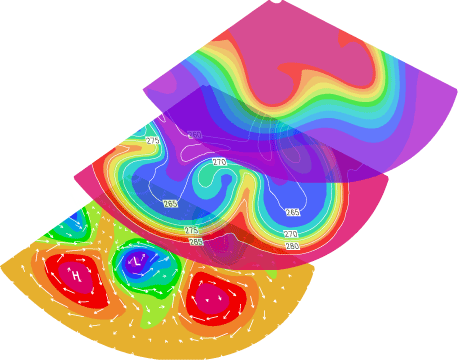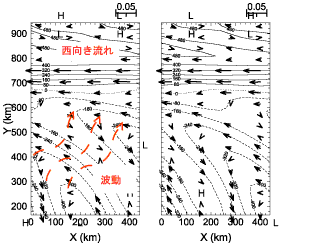Geophysical Fluid Dynamics
|
Air and water are flowing substances. These flowing substances are not classified as a gas and a liquid, but rather as fluids, and the academic field that analyzes their dynamics is called fluid dynamics. This field is fundamental for understanding atmospheric and oceanic flows, but large-scale atmospheric and oceanic flows are, at a glance, largely different from the flow of air and water we experience in daily life. For example, when looking at a weather map, we can see something called a migratory high for spring or fall. When closely regarding the flow that results alongside this high-pressure system, we understand that it travels clockwise around a high-pressure zone. However, as we know from more immediate experiences, when we swirl a cup of water, the center of the flow will always become a zone of low pressure.
|
|
The cause of this difference is the rotation of the earth or, said differently, the fact that the earth is a massive vortex (in a massive vortex, areas of slow rotation become high pressure systems.) Moreover, it is understood, when looking at an atlas, that there is a concentration of strong currents, such as the Kuroshio, at the western edge of the Pacific Ocean. Important for this phenomenon is the rotation of the earth, but also the fact that the earth is round. In this way, it is important to understand the dynamics of stratified fluids above earth’s surface (fluids with layers of density) in order to think about atmospheric and oceanic flows. Also, the academic field that systematizes the dynamics of fluids holding these types of characteristic is called geophysical fluid dynamics (or planetary fluid dynamics).
|
Research for This Course
In this course, a large body of research is being done on geophysical fluid dynamics. There exist various dynamic phenomena in the atmosphere and oceans, but by positioning them onto a simplified world that captures their essence, we are getting closer to capturing the general nature of stratified fluids above the earth’s rotating surface.
| |

|
|
|
|
|
Numerical Simulations of Fluctuations in Baroclinic Instability:
The figure at left reveals the calculated results, under ideal conditions, of large-scale atmospheric fluctuations, which reflect the reality of daily high and low pressure system. From the bottom, the figure shows wind and atmospheric pressure at the land surface, the temperature near the land surface, and the eddying situation near the tropopause.
Baroclinic instability waves in the atmosphere act against the non-adiabatic forcing of radiative and convective activity that creates large temperature differences between the tropics and the poles. They work to maintain a north-south air temperature gradient to a certain limit, but several unknowns remain with regard to the equilibration mechanism of mid-latitude atmosphere. In addition, similar instability in oceans generates strong vortexes 100 km in scale. It is thought that these vortexes play an important role in the transport of heat, matter, and momentum in oceans.
|
Average Flow Speed by Waves:
The figure at right shows 2 points in time with differing horizontal distributions of flow (vectors) and pressure (contour lines) when waves fall on an inclined surface. In contrast to flow from waves that do not oscillate in a fixed direction as time passes (bottom figure), when waves fall on an inclined surface (top figure) they flow to the west irrespective of the passage of time. This is due to the fact that waves have western momentum. By carrying this western momentum, the formation of flow becomes possible at places that are far from the area where waves are generated. This figure keeps in mind the formation of recirculation flow that results from mid-latitude oceanic jets, but the concept of wave momentum forms the basis of thought concerning the interaction of wave and flow, and also explains the dynamics of stratospheric sudden warming in the atmosphere and biannual oscillations in the tropical stratosphere.
|
|




